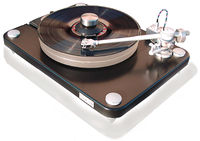| Columns Retired Columns & Blogs |
Maybe with enough money thrown in the R&D someone can find away to eliminate it. For the other 99% the antiskate (magnetic is my favourite) is a necessity of live, and a simple listening test on the inside grooves is explanation enough. What irritates me is your total buy in without question why the company left it off completely.
 I'm endlessly fascinated with the science behind them—at least partly because, as with theology and frankfurters, the real essence of the thing I'm trying to know is in fact unknowable. Given the subjectivity we bring to music appreciation and the fact that we can't see what's really going on in the groove during record play, theories and guesswork are all we have to go on in the world of phonography, notwithstanding some tedious and unintentionally funny claims to the contrary. Like it or not, wherever two or more people gather to write or read reviews of record players, faith is always close at hand.
I'm endlessly fascinated with the science behind them—at least partly because, as with theology and frankfurters, the real essence of the thing I'm trying to know is in fact unknowable. Given the subjectivity we bring to music appreciation and the fact that we can't see what's really going on in the groove during record play, theories and guesswork are all we have to go on in the world of phonography, notwithstanding some tedious and unintentionally funny claims to the contrary. Like it or not, wherever two or more people gather to write or read reviews of record players, faith is always close at hand. 




































